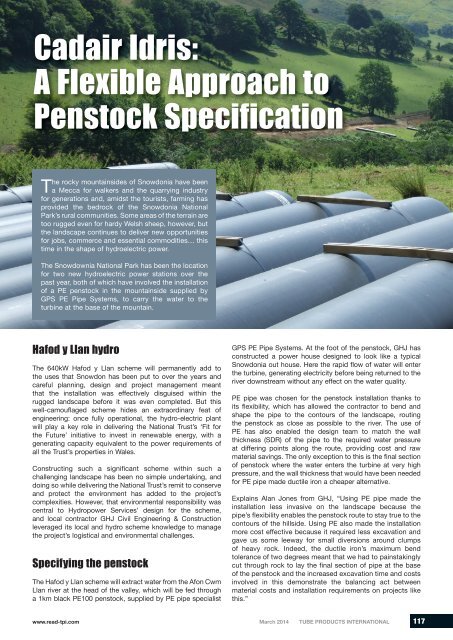You also want an ePaper? Increase the reach of your titles
YUMPU automatically turns print PDFs into web optimized ePapers that Google loves.
Cadair Idris:<br />
A Flexible Approach to<br />
Penstock Specification<br />
The rocky mountainsides of Snowdonia have been<br />
a Mecca for walkers and the quarrying industry<br />
for generations and, amidst the tourists, farming has<br />
provided the bedrock of the Snowdonia National<br />
Park’s rural communities. Some areas of the terrain are<br />
too rugged even for hardy Welsh sheep, however, but<br />
the landscape continues to deliver new opportunities<br />
for jobs, commerce and essential commodities… this<br />
time in the shape of hydroelectric power.<br />
The Snowdownia National Park has been the location<br />
for two new hydroelectric power stations over the<br />
past year, both of which have involved the installation<br />
of a PE penstock in the mountainside supplied by<br />
GPS PE Pipe Systems, to carry the water to the<br />
turbine at the base of the mountain.<br />
Hafod y Llan hydro<br />
The 640kW Hafod y Llan scheme will permanently add to<br />
the uses that Snowdon has been put to over the years and<br />
careful planning, design and project management meant<br />
that the installation was effectively disguised within the<br />
rugged landscape before it was even completed. But this<br />
well-camouflaged scheme hides an extraordinary feat of<br />
engineering: once fully operational, the hydro-electric plant<br />
will play a key role in delivering the National Trust’s ‘Fit for<br />
the Future’ initiative to invest in renewable energy, with a<br />
generating capacity equivalent to the power requirements of<br />
all the Trust’s properties in Wales.<br />
Constructing such a significant scheme within such a<br />
challenging landscape has been no simple undertaking, and<br />
doing so while delivering the National Trust’s remit to conserve<br />
and protect the environment has added to the project’s<br />
complexities. However, that environmental responsibility was<br />
central to Hydropower Services’ design for the scheme,<br />
and local contractor GHJ Civil Engineering & Construction<br />
leveraged its local and hydro scheme knowledge to manage<br />
the project’s logistical and environmental challenges.<br />
Specifying the penstock<br />
The Hafod y Llan scheme will extract water from the Afon Cwm<br />
Llan river at the head of the valley, which will be fed through<br />
a 1km black PE100 penstock, supplied by PE pipe specialist<br />
GPS PE Pipe Systems. At the foot of the penstock, GHJ has<br />
constructed a power house designed to look like a typical<br />
Snowdonia out house. Here the rapid flow of water will enter<br />
the turbine, generating electricity before being returned to the<br />
river downstream without any effect on the water quality.<br />
PE pipe was chosen for the penstock installation thanks to<br />
its flexibility, which has allowed the contractor to bend and<br />
shape the pipe to the contours of the landscape, routing<br />
the penstock as close as possible to the river. The use of<br />
PE has also enabled the design team to match the wall<br />
thickness (SDR) of the pipe to the required water pressure<br />
at differing points along the route, providing cost and raw<br />
material savings. The only exception to this is the final section<br />
of penstock where the water enters the turbine at very high<br />
pressure, and the wall thickness that would have been needed<br />
for PE pipe made ductile iron a cheaper alternative.<br />
Explains Alan Jones from GHJ, “Using PE pipe made the<br />
installation less invasive on the landscape because the<br />
pipe’s flexibility enables the penstock route to stay true to the<br />
contours of the hillside. Using PE also made the installation<br />
more cost effective because it required less excavation and<br />
gave us some leeway for small diversions around clumps<br />
of heavy rock. Indeed, the ductile iron’s maximum bend<br />
tolerance of two degrees meant that we had to painstakingly<br />
cut through rock to lay the final section of pipe at the base<br />
of the penstock and the increased excavation time and costs<br />
involved in this demonstrate the balancing act between<br />
material costs and installation requirements on projects like<br />
this.”<br />
www.read-tpi.com March 2014 <strong>Tube</strong> ProducTs InTernaTIonal 117


